First of all, what is a constellation?
Before we dive into the Perseus Constellation, let’s first take a look at what exactly a constellation is.
A constellation is an area on the celestial sphere (an imaginary sphere) where a group of visible stars are located.
These stars typically form a pattern or outline, which we perceive to represent an inanimate object, (like a question mark), an animal (like the Bear,) a mythical person (like Zeus, the Hero Perseus, King Cepheus and Queen Cassiopeia and their daughter Andromeda or even a type of creature (like Pegasus, the winged-horse, Medusa, or Cetus, the Sea Monster), from Greek mythology.
It is also an astronomy term used to describe a variety of groups of stars that have been given a specific name such as –
Constellations are constantly moving and move in the direction from East to West.
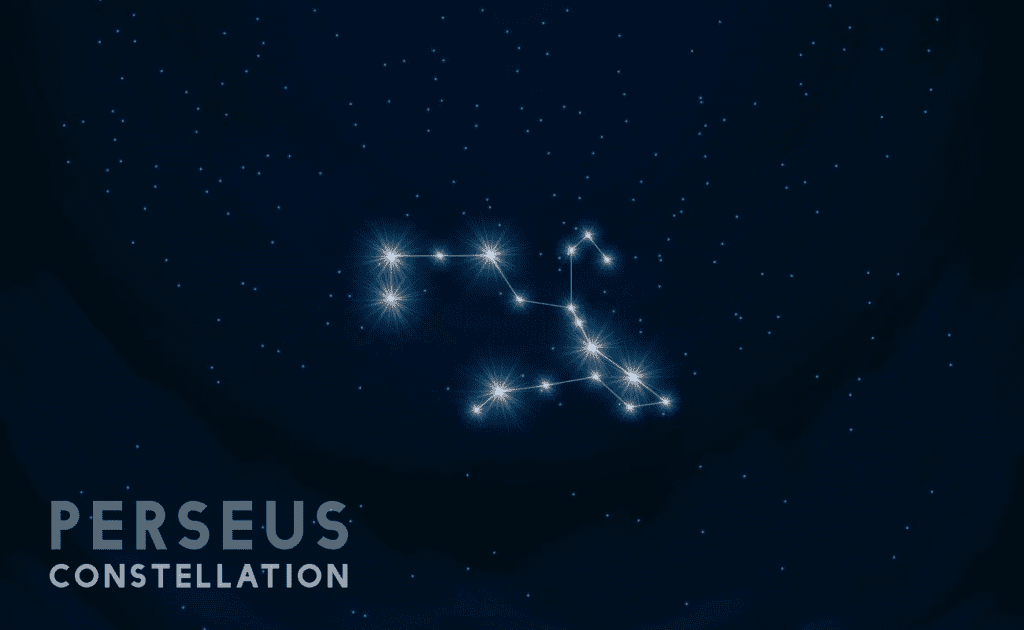
The Perseus Constellation – Facts in brief:
What is it? –
The Perseus Constellation is named after Perseus who was a popular character from Greek mythology.
The Perseus Constellation is one of the oldest known constellations, and ranks as the 24th largest Constellation as one of the original 48 Constellations listed by Greek Astronomer Ptolemy, in the 2nd century.
Perseus is one of the official International Astronomical Union (IAU) listed 88 modern constellations as seen in the night sky from Earth and listed as the 24th largest constellation.
Persei (its Latin name) is quite easy to recognize, as it clearly resembles the outline of the Greek Hero holding the severed head of Medusa, the Gorgon Medusa, in his hand.
The Perseus family, of Constellations, includes: Andromeda, Auriga, Cassiopeia, Cepheus, Cetus, Lacerta, Pegasus and Triangulum.
Where is it located? –
The Perseus Constellation is positioned in the first quadrant of the Northern Hemisphere, north of the ecliptic. It is sometimes referred to as being located in the NQ1 Quadrant.
FACT: The ecliptic is the imaginary line tracing the route that The Sun, the Moon, and the Planets take across the sky, over the year.
Where can it be seen?
Co-ordinates of a right ascension, or left ascension and their declination are used to locate all of the Constellations, like Perseus.
Perseus is most prominent in the Northern Hemisphere, in winter and springtime.
Perseus is circumpolar meaning it is visible all year round.
The Constellation of Perseus lies at 3-hour right ascension and the Declination is + 40 degrees.
It’s visible in the Northern Hemisphere at latitudes between +90 degrees and +35 degrees and covers an area of 615 square degrees in the Northern sky.
The Perseus Constellation is bordered by several other Constellations:
- Cassiopeia and Camelopardalis – to the North
- Aries and Taurus and Triangulum – to the South
- Auriga – to the East
- Andromeda, to the West
The main stars of Perseus is around 531.51 light years from Earth.
The closest star in Perseus (Iota Persei or i Persei) located around 89.93 light years from Earth. It is visible to the naked eye and has an apparent visual magnitude of 4.1.
The furthest star in Perseus (HIP 20867) and estimated to belocated around 362163.3 light years from the Sun.
Perseus has 16 bright stars, with a magnitude of 4.0 or brighter.
Mirfak and Algol are the brightest stars and the only two visible from locations with light pollution.
How can you identify Perseus?
The simplest method for spotting any particular Constellation from Earth is to first of all locate the brightest star in that Constellation, and then look at the neighboring illuminations, to see if you can identify a recognizable pattern.
The Perseus Constellation can be recognizedin the night sky as the outline of the body of a man, where you can imagine his head, two arms and two legs; the Hero Perseus, from Greek Mythology.
You simply locate its 2 brightest stars, Mirfak (Alpha Persei) the main star representing the center of the body of Perseus, and Algol (Beta Persei), representing the right leg of Perseus, by the Gorgon Medusa’s head.
The brightest stars of Perseus can be viewed from Earth, from a northern location, by the naked eye.
The Star System within Perseus
The Constellation of Perseus has about 17 bright Stars making up the imaginary outline of Perseus.
The main bright stars that form the ‘man’ shape, listed from brightest Star to fainter:
- Mirfak (Alpha Persei)
- Algol (Beta Persei)
- Atik (Zeta Persei)
- Epsilon Persei
- Gamma Persei A
- Gamma Persei B
- Delta Persei
- Rho Persei or Gorgonea Tertia,
- Eta Persei
- V Persei or Nu Persei
- Kappa Persei
- Omicron Persei
- Xi Persei
- I Persei – Iota Persei
- Theta Persei
- PSI Persei
There are many named Stars within Perseus that have been approved by the International Astronomical Union (IAU):
Location of Perseus
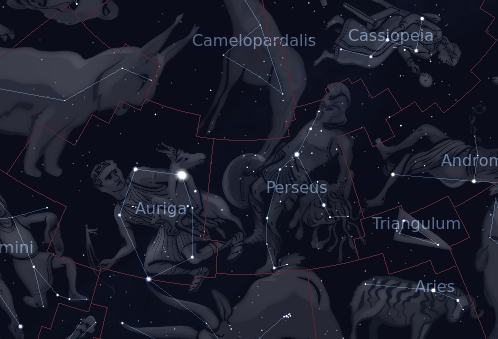
Perseus can be spotted in the Northern Hemisphere, also referred to as the Northern sky. It includes a dense portion of the Milky Way and contains several star clusters and the variable star ‘Algol’.
The Constellation Perseus is surrounded by various recognizable Constellations, and located by its two brightest stars Algol (alpha Persei) and Mirfak (Beta Persei).
The Perseus Constellation is a well-known guide-point in the sky used by astronomers and amateur stargazers to identify certain Deep Sky objects; like the neighboring Andromeda Galaxy.
When to see the Constellation Perseus
The best months to spot the Constellation of Perseus in the Northern Hemisphere is December.
The best time of day to spot it is around 21.00 at night (22.00 Daylight Saving Time) local time around the world.
How was it formed, found and named?
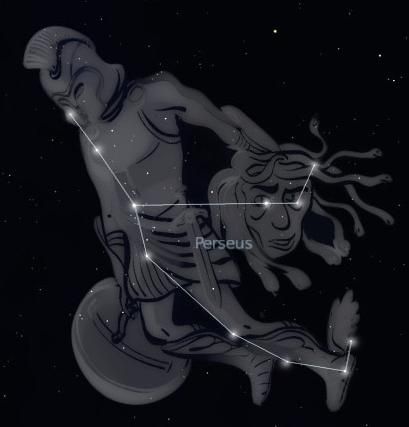
Perseus is a Constellation in the sky and one of the 88 Constellation listed in the official IAU chartpublished by the International Astronomical Union (IAU). It fills an area of 615 square degrees.
- Initially, the shapes of their star patterns informally categorized the Constellations in the sky.
- Eventually, the IAU published the official listing of constellation boundaries. This maps the constellations by their sky coordinates not by the line patterns and shapes they are referred to by.
What’s within the Perseus Constellation?
The Perseus Constellationc ontains:
- 17 main stars, including Atik – Zeta Persei, Epsilon Persei and Gorgonea Tertia
- 7 stars that host exoplanets
- 2 Messier Objects –
- Messier 34, (M34, is an open cluster and also referred to as NGC 1039), and
- Messier 76, (M76, also referred to as NGC 650, the Little Dumbbell Nebula which is a planetary nebula) to to be confused with it’s big brother ‘Dumbbell Nebula – Messier 27′.
- 2 associated meteor showers known as the ‘Perseid Meteor Showers – ‘The Perseids’ and ‘The September Perseids’. The Perseid Meteor Shower is associated with the comet Swift-Tuttle. These meteors are called Perseids because they appear to come from a point within Constellation Perseus. They are best seen mid July to mid August.
FACT: A Deep Sky Object is defined as an astronomical object that is not part of our solar system.
Deep Sky Objects include star clusters such as Globular Clusters of Stars, Open Clusters of Stars, Dark Nebula, Planetary Nebula, Diffuse Nebula, and Supernova remnants, Galaxy Groups, Galaxies, Gravitational Lenses and Quasars.
(But not single Stars!)
Within the Constellation Perseus
The Constellation of Perseus is formed by of a number of different components – mainly Stars, Deep sky objects and Messier objects (galaxies).
Stars
There are many different types of Stars in the star system categorized by size, lifespan and luminosity. Generally, larger Stars have a shorter lifespan.
Stars are formed from clouds of interstellar gas and include:
Red Dwarf Stars
Most of the stars in the galaxy are Red Dwarf Stars. They are small in size measuring about 40-50% of the mass of The Sun. They are cool and their luminosity has only about 10% of the brightness of the Sun (our brightest Star), and they live for longer.
Brown Dwarf Stars
These are known as failed stars that form like other stars but don’t reach the mass, heat or density to begin the nuclear fusion process. They are only about 8% of the mass of the Sun and are red not brown, and not easy to spot in the night sky.
Red Giant Stars
These are giant luminous stars that have a low or medium mass. A Red Giant Star is formed when a star expands its volume by fusing all of its hydrogen into helium, and then burning the helium to produce carbon and oxygen to expand.
Blue Giants
These are giant, bright stars that range from 10-100 times the size of the Sun and are 1000 times brighter. They are big and hot and therefore burn out quickly. The biggest are called Blue super giants or hyper giants. The biggest ever discovered was about 10 million times brighter than the Sun,
Yellow Dwarfs
These are main-sequence stars like the Sun, but only 80% of its size, and are bright stars,
White Dwarfs
These are small burnt out husks of stars, about the same size as the Earth. White Dwarfs are dense and represent the final state of evolution for a star, like most stars in the galaxy.
Black Dwarfs
These are the remains of a White Dwarf after it cools and darkens. This is likely to happen after about 10 billion years of life.
White Stars
These are also main-sequence stars like the Sun, but twice the size, and are bright stars and hot.
Other types of stars include the Orange Giant, Neutron stars, Variable Stars and Binary Stars
What is a Bright Star?
The sky is home to various bright stars. The brightness of a star is measured by a value called its magnitude (apparent magnitude) and they come in different sizes, composition, mass and color.
Their vast distance away from us is measured in light years from either Earth, the Sun or the Milky Way.
The lower the magnitude value the brighter the star appears in the night sky when viewed from Earth.
FACT: The Sun is considered to be the brightest star in the sky.
Perseus has 15 formally named stars that have been officially approved by the International Astronomical Union (IAU):
As well as Stars, the Perseus Constellation also has deep sky objects and galaxies (or even globular clusters or open clusters).
Deep Sky Objects
FACT: A Deep Sky Object is an astronomical object, that is not a solar system object like the Sun, Moon, Comet or a Planet. An individual Star is not considered to be a Deep Sky Object.
Deep Sky Objects are faint objects that can still be observed by the naked eye in the night sky from Earth.
They include Galaxies, Star Clusters and Nebulae.
What is a Nebula?
A Nebula is a massive cloud of gas and dust in Space.
Some Nebulae are formed when a star explodes and then dies, like a Supernova. Sometimes they can act as Star nurseries where new Stars are forming.
The Nebulae are the spaces in between the stars referred to as interstellar space.
There are several types of Nebulae:
- Bright Nebulae,
- Emission Nebulae,
- Reflection Nebulae,
- Dark Nebulae
- Planetary Nebulae
The California Nebula
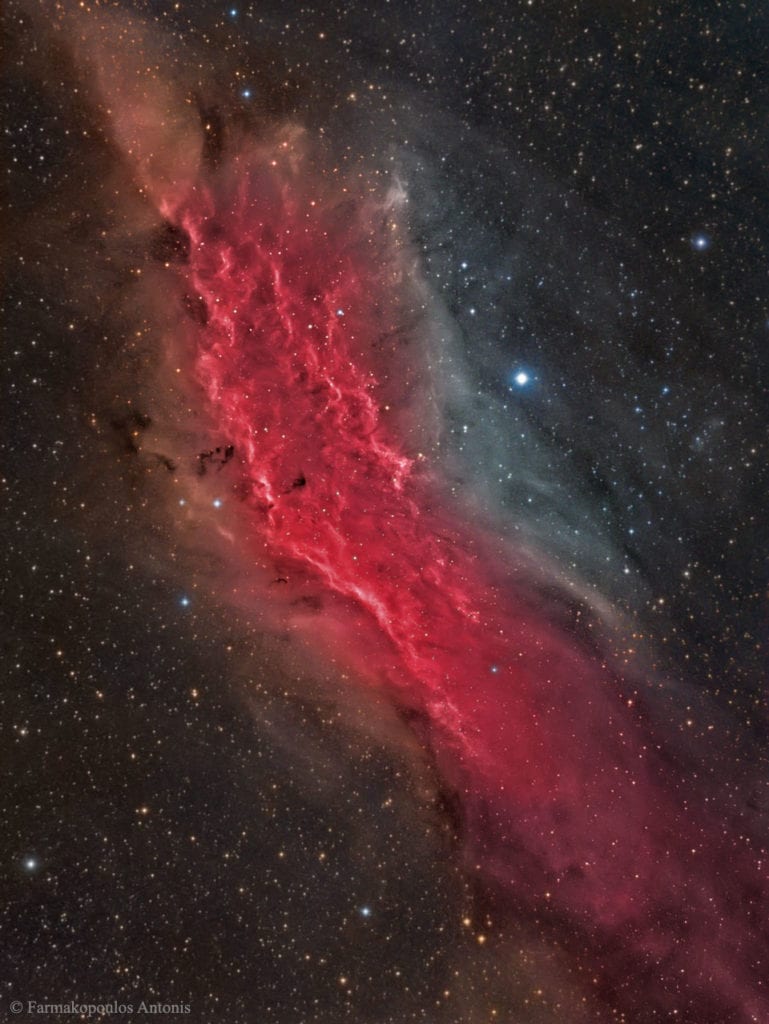
The California Nebula (NGC 1499) is an emission Nebula within the Perseus Constellation. It gets its name from the fact that it resembles the Shape of the State of California, USA.
The NGC 1499 nebula is located approximately 1,000 light years from Earth.
NGC 1333
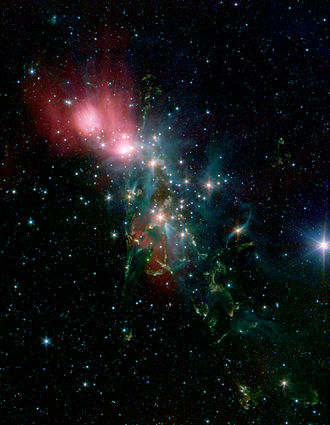
NGC 1333 is a reflection nebula in the Northern Constellation Perseus. It is positioned close to the Southern Constellation border with Aries and Taurus. I
It was discovered in 1855.
FACT: a ‘reflection nebula’ is an interstellar cloud that should be a dark nebula (a molecular cloud) however its dust reflects light from a nearby bright star and it reflects the light, hence the name.
Images of the Nebulae have been captured using professional Space telescopes, such as the NASA Spitzer Space Telescope, operated by NASA, and the famous Hubble Space Telescope.
What is a Messier?
A Messier is a cluster of Stars
Constellation Perseus has 2 Messier objects called Messier 34 (NGC 1039), an open cluster and Messier 76 (NGC 650/651) another open cluster.
Charles Messier, a French astronomer, is credited with cataloging each Messier Star cluster, around 1764.
His astronomical catalogue, the New General Catalogue (used in its abbreviated form NGC and numbered), lists 110 nebulae and star clusters,
These later became known as the Messier objects.
FACT: A star cluster is a large group of Stars that can be Globular Clusters or Open Clusters:
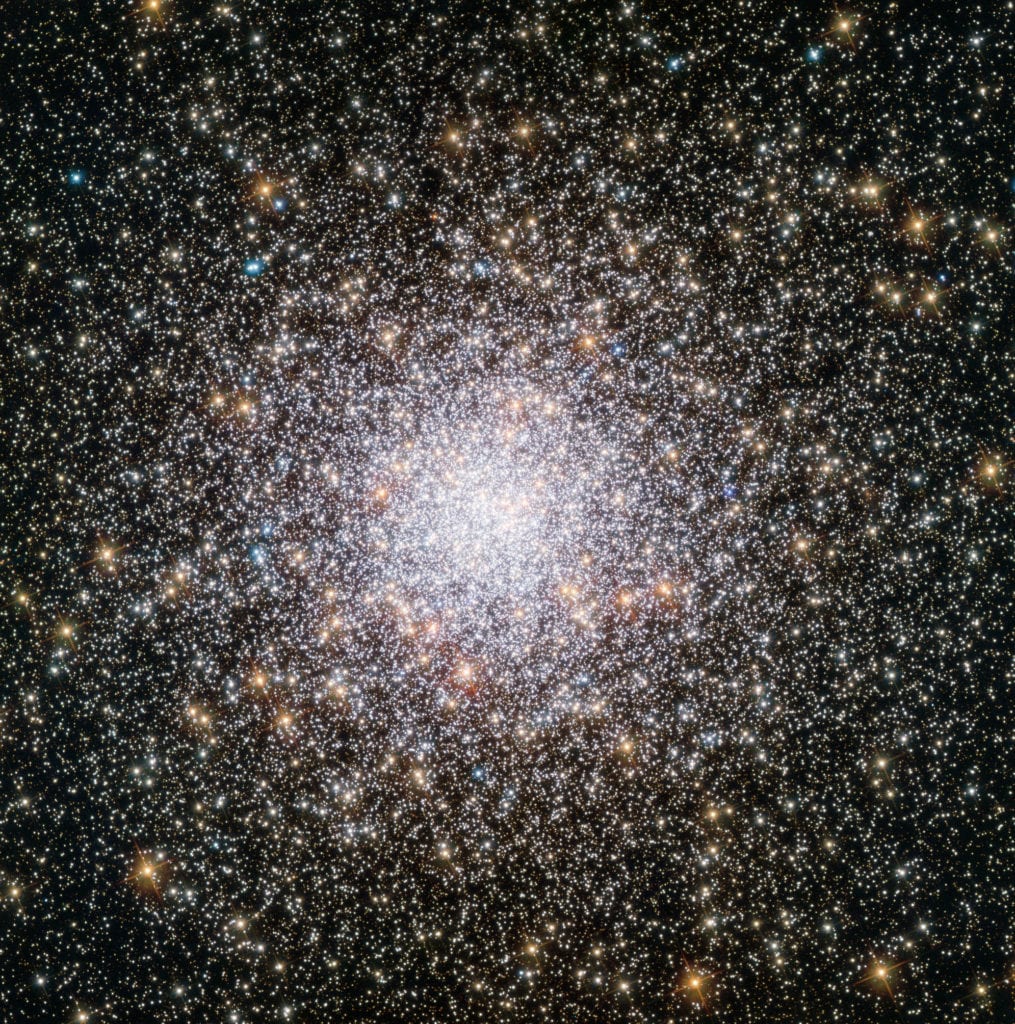
- Globular Clusters:
A global cluster is a spherical collection of ‘Old Stars’, numbering hundreds to millions, that are tightly bound by gravity and orbit a galactic core.
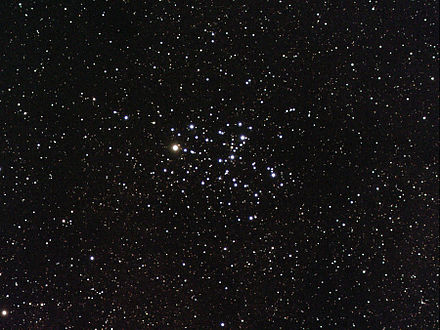
- Open Clusters:
An open Cluster is a looser formation of ‘Young Stars’ that generally has less than a few hundred Stars.
The Constellation of Cassiopeia can be used to locate the double cluster of Perseus.
The Perseus cluster
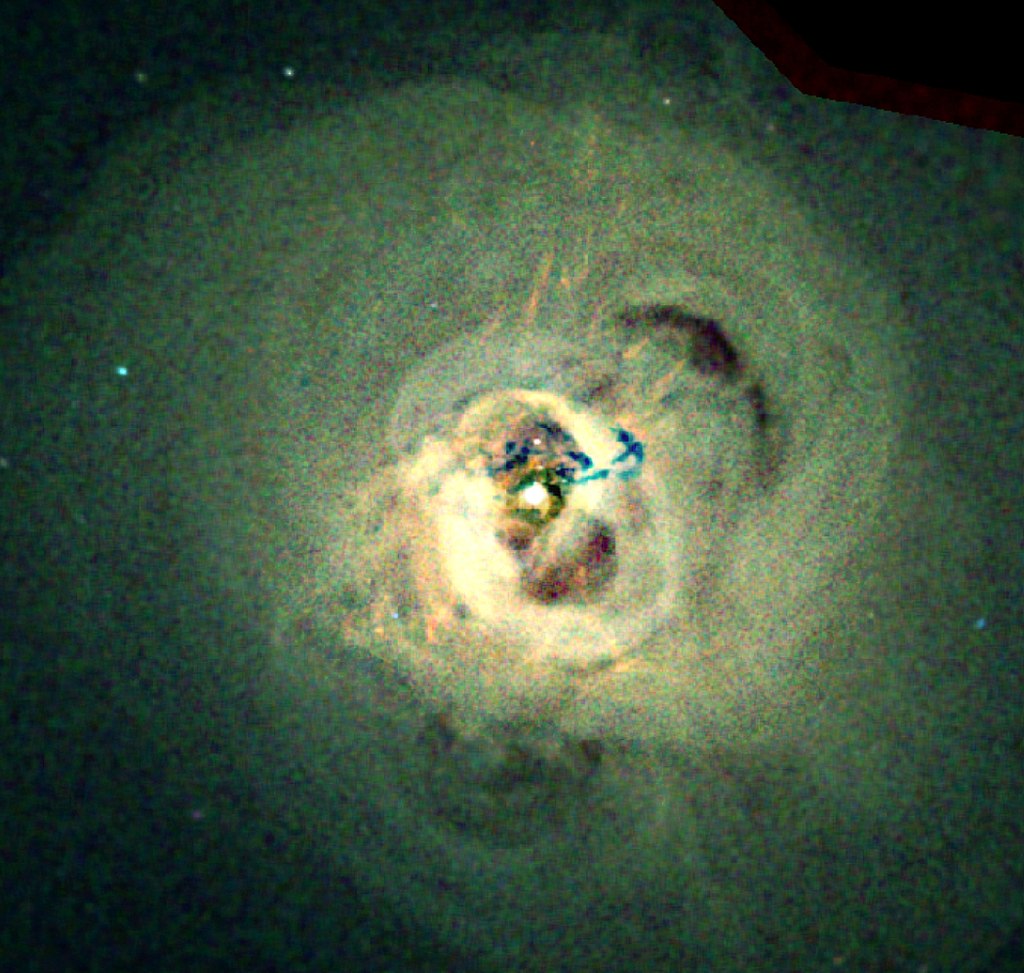
The Perseus Cluster, the double cluster, is not one open cluster, but two individual open clusters: NGC 869 (h Persei) and NGC 884 (x Persei).
NGC 869 and NGC 884 are visible by naked eye and lie at a distance of 7,500 light years.
The Perseus Cluster is a cluster of Galaxies within the Constellation of Perseus. It’s also named ‘Abell 426’.
This Perseus Cluster is considered as one of the massive objects in the known universe, and contains thousands of galaxies surrounded by a vast cloud of multimillion-degree gas.
The brightest member of the Perseus cluster is NGC 1275.
NGC 1275, (the Perseus A radio galaxy, or Caldwell 24),is located in the center of the Perseus Cluster of Galaxies. It’s a type 1.5 Seyfert galaxy that lies around 237 million light years from Earth.
The Messier Marathon
The best time of year to view all 110 Messier objects at the same time, providing night sky conditions are positive, is between mid to late March and early April.
Supernova Remnants
A supernova remnant is the structure that’s left after a star explodes in a supernova.
There are 3 types of supernova remnants: shell-like, composite and mixed-morphology (or thermal composite).
Spiral Galaxies
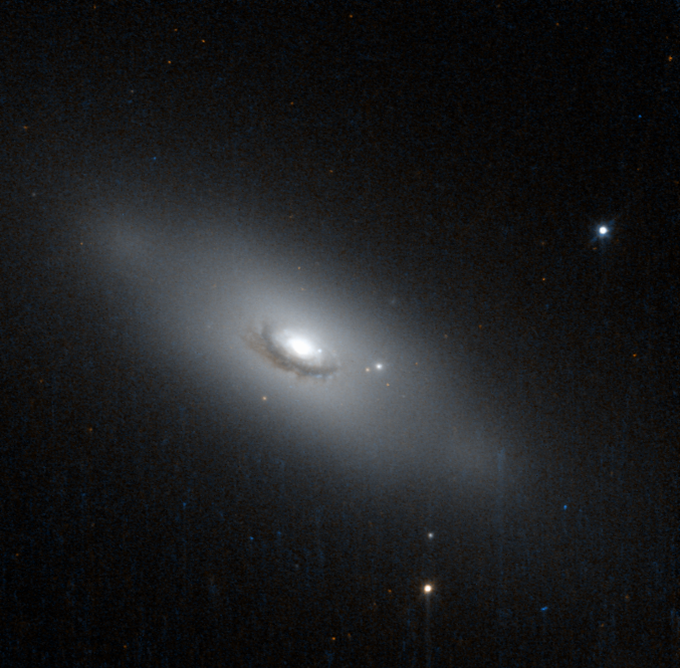
NGC 1260 (a spiral galaxy, or lenticular galaxy) is found in the northern circumpolar Constellation of Perseus.
As a member of the Perseus Cluster, NGC 1260 is located close to the PGC 12230 Galaxy and home to the second brightest supernova SN2006gy.
(Defined a Supernova, first observed in 2006, and discovered by Guillaume Bigourdan an astronomer), with an apparent magnitude of 14.3.
What is the Milky Way?
The Milky Way is a Spiral Galaxy, containing over 200 billion Stars, forming part of the Constellation of Sagittarius. It is the Galaxy containing our solar system . Its name suggests it looks like a hazy swirl or river of milk across the sky.
It’s composed of gas, dust and stars, with spiral arms wrapped around it, and a massive black hole in the center of the Galaxy. It looks brightest when looking towards the galactic center in the direction of Sagittarius.
The Stars in the Milky Way are many light years away and cannot be individually identified by naked eye.
The Perseus arm (the double cluster) contains two open clusters – NGC 869 and NGC 884 and is a spiral arm of the Milky Way galaxy.
The Perseus arm stretches from the Constellation Cassiopeia, through Constellation Perseus, Constellation Auriga reaching Gemini and Monoceros.
Background & Facts:
The Greeks were the first ancient culture to name the 88 Constellations in the sky.
Ptolemy

The Greek Astronomer – Ptolemy, first cataloged the Constellation of Perseus, in the 2nd Century (2 AD.).
Ptolemy listed the various constellations in his Almagest (a book recording astronomical data).
Bayer

In 1903, German Astronomer – Johann Bayer, systematically assigned names to the 26 brightest stars in Cassiopeia and cataloged them in his Star atlas – ‘Uranometria’.
The Bayer designations are stellar designations where the stars within Constellations are initially identified by a name or a letter from the Greek Alphabet, from Alpha through Omega (in order of brightness).
1. The names of the Stars begin with a Greek letter starting with – Alpha
2. Followed by the genitive form of their parent constellation’s Latin name – ‘Perse’ with ‘i, makes the name ‘Persei’
3. Giving the first Perseus Star name Alpha Persei
The main stars of Cassiopeia are named by their apparent magnitude (luminosity) from the brightest to faintest:
- Alpha Persei (Mirfak or Algenib) – a bright multiple Star, and circumpolar star. Mirfak is the Arabic word for ‘elbow’.Algenib is the Arabic word for ‘the side’
- Beta Persei (Algol) – the Demon Star
- Zeta Persei (Atik) – Menkhib, bright multiple star, one of first non-nova variable Stars discovered
- Epsilon Persei- easily seen by naked eye – multiple star system, easily viewed by naked eye
- Gamma Persei A – a binary star system
- Gamma Persei B – a binary star system
- Delta Persei – double star and visible to naked eye
- Rho Persei also known as Gorgonea Tertia, 3rd member of the Gorgonea quartet
- Eta Persei – binary star and ´A` of triple star
- V Persei or Nu Persei – single star and possible variable star
- Kappa Persei – triple star system
- Omicron Persei- triple star system
- Xi Persei – Menkib or Menkhib
- I Persei – Iota Persei, single star and visible to naked eye
- Theta Persei – star system, 37 light years from earth
- PSI Persei – a Be star, visible to naked eye
The importance of Constellations like Perseus dates back to Babylonian times. They identified constellations with bright Stars.
The shape of Perseus
The Bright Stars
If you look up and into the night sky you can imagine the recognizable outline of the Constellation of Perseus, as a man.
This main constellation is made up of 17 main bright Stars
Stars with Planets
Perseus has 7 Star systems with exoplanets orbiting around them in the solar system but they are unlikely to be able to support life forms.
The furthest exoplanet discovered was actually in the Andromeda Galaxy, not in the Milky Way.
Not all the stars within the Perseus Constellation are visible to the naked eye but with telescopes and modern imagery techniques is it possible to glimpse all of the stars.
FACT: An exoplanet (also referred to as an extrasolar Planet) is a planet that orbits a Star that is not located within our Solar System (exoplanets do not orbit our Sun)
Nothing stands still in the sky.
Planets are continually being discovered and lists updated.
The Constellations change their positions throughout the year as the Earth rotates around the Sun.
This means our position in space is forever changing and as a result our view of what’s in space changes too, and will continue to do so.
Why and what is the purpose of Perseus? –
In ancient times the dots, bright lights and perceived objects in the sky were of great interest and the makings of folklore to a great range of people from seamen to farmers.
From children to the elderly, we have had an ongoing fascination, with our solar system and star system. Perhaps it’s because the enormity and variety within it makes us realize just how large and exciting the universe is.
FACT: The Star System or Stellar System is a small number of stars that orbit around each other and are bound together by gravity.
When it becomes a large group of stars, again bound together in the same way, by gravity, it is known as a Galaxy or Star Cluster.
Whether they contain small groups of stars or larger groups of start the both come under the classification of ‘Star System’.
The Perseus celestial pole
The celestial pole defines the poles of the celestial equatorial coordinate system.
An object at the Celestial pole has a declination of 0 degrees.
- The declinations for the north celestial pole is +90 degrees
- The declinations for the south celestial pole is -90 degrees
The celestial poles are not permanently in a fixed position against the background of the stars as everything moves in Space.
Perseus is located in the northern celestial sky at a +40 degree north declination and a 4 hours right ascension.
Navigational tools in the sky
The many Constellations in the night sky were a useful navigation tool and guide as well as the subject of legends and myths.
42 of the Constellations have been named after animals with a story behind each name.
Historical significance: the legends, and myths surrounding Constellation of Perseus
Myths
When it comes to the many recognized constellations in the sky, Perseus is one of the largest Constellations.
When Ptolemy, the Greek astronomer, catalogued Perseus as far back as the 2nd century, it became a topic of great interest in Greek mythology and in other ancient civilizations.
However the origins of the earliest Constellations probably date back to prehistory.
Many ancient civilizations have related the Constellations in the sky to suit their beliefs and creation itself. They have been the subject of folklore and experiences for a very long time.
Greek mythology

There are many Greek myths and legends surrounding the origin and names of the constellations.
Acrisius, the King of Argos, and father of Danae, was told by the oracle of Apollo that one day he would be killed by his Grandson. He therefore imprisoned his daughter, Danae in a bronze underground chamber so she could not meet anyone to have children with. Zeus however discovered her underground and they had a child named Perseus.
Acrisius was so angry when he discovered the baby that he locked Danae and baby Perseus in a crate and threw them into the sea. The crate floated to the Island of Seriphos that was ruled by King Polydectes. They were washed ashore and rescued by Dictys, the brother of King Polydectes.
King Polydectes fell in love with Danae the moment he saw her, but she rejected him. He decided Perseus was the obstacle, so he needed to get rid of her son, so he brought Perseus a wife and asked for a horse as a bride gift. Perseus was poor so he asked to bring a different gift.
So, King Polydectes set him a dangerous task instead and asked him to bring him the head of the gorgon Medusa, assuming she would turn him into stone with one look, and then he could marry Perseus’s mother Danae.
Perseus accepted the challenge and cut off the head of Medusa and then used her head as a weapon. He turned Polydectes into stone for harassing his mother and accidently killed his grandfather, Acrisius, as per the prophecy.
The Constellation Perseus is identified as the outline of the body of Perseus, the Hero
The other myth of how Perseus rescued Andromeda
The myth begins with Cassiopeia, the wife of King Cepheus, of Ethiopia, who was a vain queen. Together they had a daughter Andromeda. Cassiopeia boasted that she was more beautiful than all of the 50 Nereids (the Sea Nymphs).
The angry Sea Nymphs asked Poseidon, the god of the sea, who was married to the Sea Nymph (Amphitrite), to punish Cassiopeia. He obliged and sent the Sea Monster Cetus to ravage her kingdom.
To appease the Sea Monster, Cassiopeia tied her daughter Andromeda to a rock for him to eat. The hero Perseus, on his winged horse Pegasus, rescued Andromeda just in time, from being devoured by Cetus. They married and lived happily ever after.
The gods were so happy at the outcome that they placed them in the heaven as stars. However, to show their displeasure with Cassiopeia she was tied to a chair and also put in the heavens where she revolves around the celestial pole, sometimes in an upside down position.
Ancient associations with the constellations
The Greeks, Romans and the Sumerians were all interested in the constellations in the sky.
The Sumerians were the first literate civilization of the Ancient Mesopotamia (an area occupying parts of Turkey and the Syria of today, Iraq, Iran)
The Sumerian civilization was not unified like the ancient Greek or Roman civilizations it was bonded by a common attitude.
Their belief systems featured many deities. They regarded their gods as being responsible for everything and as such held them in great respect. Many stories arose as a result.
For thousands of years, various cultures around the world have identified and named the constellation we know and see in the night sky as Cassiopeia.
The Mesopotamian civilization (the first known civilization) identified constellations like Perseus
FACT: The ancient lands of the Mesopotamians now stretches across Turkey, Syria, Iraq and Kuwait
Perseus and the other constellations in the sky were not only the subject of legends but they had a practical use too.
The ancient Mesopotamians used the orientation of the constellations to set the seasons for sowing crops and harvesting.
The Babylonians also recorded details of various bright stars within the constellations in their Babylonian star catalogues before 100BCE.
What is the difference between a constellation and an asterism?
An asterism is a group of stars that appear to form a pattern in the night sky but with no officially determined boundaries. It can make up part of a constellation, cross the boundaries of an official constellation or even a defunct constellation.
An asterism is a more vague assembly of stars than a recognized constellation.
The meteor showers of Perseus

There are 2 annual meteor showers associated with the Constellation of Perseus; they are known as the ‘Perseids’ and the ‘September Perseids’.
The Perseids are one of the brightest meteor showers and are associated with its parent body the comet ‘Swift-Tuttle’. The point they appear to come from lies within the constellation of Pegasus.
The name comes from the Greek word Perseidai meaning the ‘sons of Perseus’
The Perseids meteor shower occurs between July 17 and August 24 each year. Its peak around August 9-13 every year and is visible in the Northern Hemisphere.
The meteor shower is associated with the constellation of Perseus because the point at which they appear is located in that direction.
In the Catholic religion the Perseids are referred to as the ‘tears of Saint Lawrence’.
This Saint was burned alive and the story according the Mediterranean folklore is that he returns to earth every year on August 10, as a shooting star (the date of the Saint’s martyrdom).
When the embers from the meteor shower cool they appear under plants as earth.
Fun Facts about Constellations – Did you know that?
- Mirfak or alpha Persei (the brightest star in Perseus) hosts an exoplanet and is 120 times bigger than the Sun. It’s within the Alpha Persei Cluster and its exoplanet would be around 660% of the mass of Jupiter.
- Perseus is usually depicted as the hero holding Medusa’s severed head in one hand and a jeweled dagger in the other. Algol (Beta Persei), the Demon Star, represents Medusa’s head
- An X-ray astronomy satellite studies X-ray emissions from celestial objects
- There are over 4000 known exoplanets, with another 5000 awaiting classification
- The scale of a Constellation is measured in square degrees
- Charles Messier, the French Astronomer who cataloged the Messier objects, has a crater on the Moon named after him.
- Constellations like Perseus are not part of our Solar System; they are groups of stars that appear to form shapes that are visible with the naked eye from Earth.
- The largest Constellation is called Hydra and the smallest Constellation is called Crux
- The Sun does not belong to any constellation.
- A Constellation does not actually exist as a fixed object, it is a group of bright stars that happen to be in a random place and are light years apart and ever moving. We see the pattern of their presence.
- The center of a Galaxy does not contain a Giant Star it contains a massive Black Hole.
- Red Dwarf is not a Dwarf Planet it is a Star. Most common Stars are Red Dwarf (cool Stars)
- Spiral Galaxies make up about two thirds of all the Galaxies in the Universe
Commonly Asked Questions
Q. What is the celestial sphere?
A. In astronomy and navigation terms, the celestial sphere is imaginary.
This virtual sphere has a large radius that is concentric with Earth.
We can imagine all objects in the night sky as being projected upon the inside of this celestial sphere, as if it has images placed inside a dome.
Q. What’s the difference between a Constellation and an asterism
A. The stars that make up a Constellation have a definite position and form, whereas an asterism is a collection of stars without a fixed position.
Q. What prevents us seeing the Stars and Constellations in the night sky?
A. Light pollution, fog, city lights and artificial lights all limit our visibility of the objects in the sky at night.
Q. Will the Constellations change over time?
A. The Constellations are continually on the move.
The images we form in our imagination to make objects, shapes and patterns out of the constellations have already shifted over time.
As we view the night skies from Earth they are likely to continue to shift and possibly in time the images may look very different.
Image Sources:
- https://www.stockunlimited.com/vector-illustration/perseus-constellation_1555399.html
- https://in-the-sky.org/data/constellation.php?id=64
- https://www.pinterest.ca/pin/330099847665171042
- https://apod.nasa.gov/apod/ap160112.html
- https://en.wikipedia.org/wiki/NGC_1333
- https://astronomynow.com/2016/10/24/hubble-reveals-ngc-362-a-young-globular-cluster
- https://www.wikiwand.com/en/List_of_open_clusters
- https://en.wikipedia.org/wiki/Perseus_Cluster
- https://en.wikipedia.org/wiki/NGC_1260
- http://www.hellenicaworld.com/Greece/Science/en/PtolemyAstronomy.html
- https://alchetron.com/Johann-Bayer
- https://www.youtube.com/watch?v=-tn3m-sQJYk
- https://www.forbes.com/sites/jamiecartereurope/2020/08/04/everything-you-need-to-know-to-see-fireballs-during-the-perseid-meteor-shower-2020/?sh=23d4018a449c